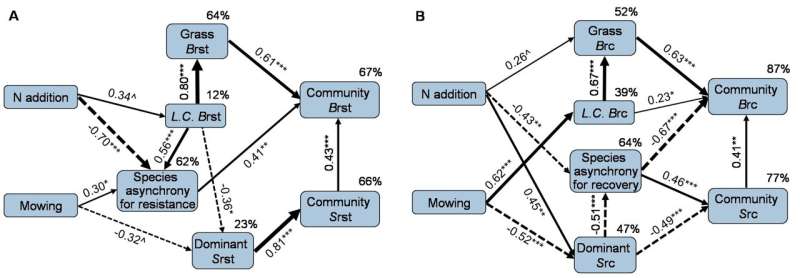This article has been reviewed according to Science X's editorial process and policies. Editors have highlighted the following attributes while ensuring the content's credibility:
fact-checked
peer-reviewed publication
trusted source
proofread
Nitrogen addition and mowing alter drought resistance and recovery of grassland communities

The effects of increased nitrogen input and mowing on the resistance and recovery of temperate grassland experiencing a three-year natural drought (from 2015 to 2017) were investigated based on a five-year field manipulative experiment.
The experiment was conducted during 2014 to 2018 at the Erguna Forest-Steppe Ecotone Research Station in Erguna of Inner Mongolia, China. Nitrogen addition (+10 g nitrogen m−2yr−1, N), mowing, and N plus mowing were implemented annually as treatments with natural communities receiving no nitrogen addition and no mowing as control. Species composition and aboveground biomass of plant communities were surveyed in each growing season during the five-year experiment.
The results of the experimental show that nitrogen addition increased grassland biomass recovery but decreased structural recovery after drought, whereas annual mowing increased grassland biomass recovery and structural recovery but reduced structural resistance to drought. These findings illustrate the necessity of considering stability across multiple levels of ecological organization to gain a more complete understanding of the effects of anthropogenic environmental changes on ecological stability.
The researchers also found the effects of nitrogen addition and mowing on community biomass/structural resistance and recovery were mainly regulated by the stability of the dominant species and asynchronous dynamics among species, and the community biomass resistance and recovery were also greatly determined by the stability of grasses.
These results highlight the importance of dominant species and specific plant functional group, as well as the complementarity effects among species for determining both biomass and structural stability of temperate grassland experiencing drought.
This study provides evidences on the substantial influences of increase in nitrogen enrichment and mowing on drought responses of temperate grasslands, and has important implications for grassland management under increasing anthropogenic disturbance and extreme climate events.
The study is published in the journal Science China Life Sciences.
More information: Zhuwen Xu et al, Nitrogen addition and mowing alter drought resistance and recovery of grassland communities, Science China Life Sciences (2023). DOI: 10.1007/s11427-022-2217-9
Journal information: Science China Life Sciences
Provided by Science China Press

















